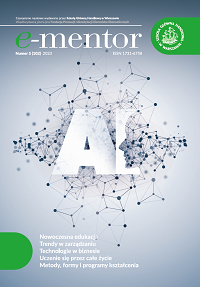Twórcze nauczanie i nauczanie do twórczości w doświadczeniach wykładowców innowatorów
Creative teaching and teaching to creativity in the experiences of lecturers-innovators
Author(s): Zofia OkrajSubject(s): Education
Published by: Szkoła Główna Handlowa w Warszawie, Fundacja Promocji i Akredytacji Kierunków Ekonomicznych
Keywords: didactic innovation; creative thinking; creative teaching; teaching to creativity; ESA theory
Summary/Abstract: Teaching students creatively and teaching them to creativity in the realities of the university requires from the academic teachers: willingness, invention, knowledge, skills and their own creative competences. Their highest level - related to the teacher's professional creativity - is the innovative activity related to the implementation of new didactic solutions into academic didactics. These innovations are the result of many years of creative didactic work carried out by academic teachers. This text contains excerpts from the results of research on the experiences of Polish academic teachers-innovators who have implemented new and valuable paradigms, strategies, concepts, models, workshops, teaching techniques, as well as accompanying didactic means and methods of student assessment, which are useful in the context of the course and outcomes of education. The theoretical and methodological concept of ESA (The Evolving Systems Approach to Creative Work) by Howard E. Gruber was used in the qualitative research. The use of multiple case studies, semi-structured interviews and analysis of the content of publications by the surveyed teachers and photos from classes conducted with students allowed the researcher to learn about the determinants of the creative work of teachers-innovators. One of the distinguishing features of the didactic workshops created by the surveyed teachers is creative teaching and teaching to creativity. In this process, the surveyed innovators use many didactic solutions, including those developed by themselves. The aim of this study is to describe and characterize them, as well as to inspire other academic teachers to activate students' creative thinking, which - as the research shows - can be a creative, attractive and rewarding activity for both students and teachers.
Journal: e-mentor
- Issue Year: 102/2023
- Issue No: 5
- Page Range: 38-47
- Page Count: 10
- Language: Polish

